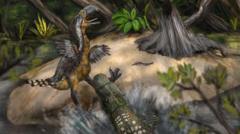Scientists have uncovered evidence suggesting a dramatic encounter between two prehistoric apex predators in Colombia's Tatacoa Desert, dating back 13 million years. A fossilized leg bone from a terror bird, a fierce avian predator, reveals distinct teeth marks that imply a fatal attack by a larger caiman, a crocodile-like reptile.
The analysis, published in the journal Biology Letters, utilized 3D digital scans to compare the bone's bite marks with the teeth of extinct crocodilian predators, leading researchers to believe this terror bird fell victim to the caiman during a battle for survival. The strikingly detailed teeth impressions indicate there was no healing observed, implying the bird likely met its end during this encounter.
The first discovery of the leg bone occurred over 15 years ago in the Tatacoa Desert, which was once a humid swamp teeming with life. Residing in these wetlands, the terror bird stood approximately 2.5 meters tall and was equipped with powerful legs and a lethal hooked beak, adept for hunting.
Lead researcher Andres Link noted the significance of these findings, indicating that they provide rare insights into predator interactions among extinct species. He confirmed the teeth marks align with those of the caiman species Purussaurus neivensis, which could have reached lengths of five meters and practiced ambush predation, similar to modern-day crocodiles.
Link, alongside local fossil collector César Augusto Perdomo, has worked diligently to study and catalog these fossils, profoundly enhancing our understanding of the region's prehistoric life. With each fossil analyzed, as per Link, "we gain more insight into the vast narrative of life that once existed on Earth."
This revelation about the vulnerability of terror birds to other predators underscores the complex dynamics of ancient ecosystems and challenges previous assumptions about their dominance as top predators. The meticulous work of researchers continues to unveil the mysteries of our planet's distant past and the behaviors of its ancient inhabitants.


















